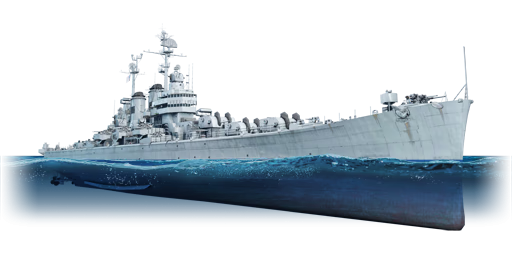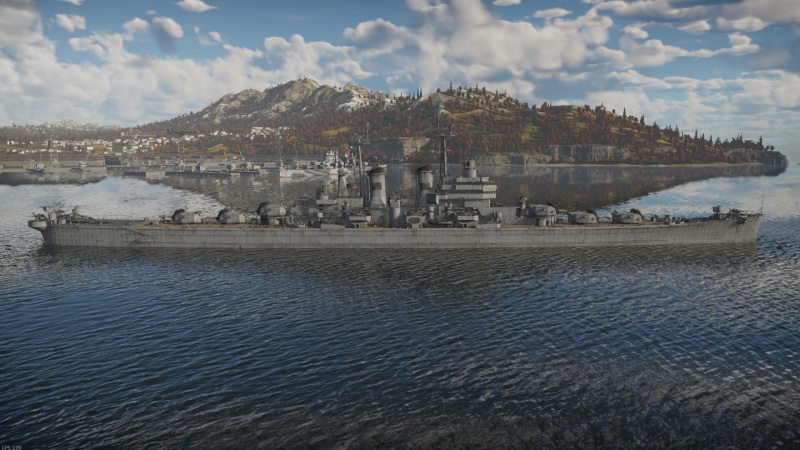USS Roanoke
Contents
Description
The Worcester-class light cruiser are the final class of "gun cruiser" built for the United States Navy, being laid down just a few months before the end of World War II. The class was, in concept, built as a distinctive hybrid between the Cleveland-class and Atlanta/Juneau-class light cruiser, featuring twelve 6-inch guns mounted in six twin turrets arranged in linear configuration. Each 6-inch guns were intended to be dual-purposes, and as such they were housed inside a turret with high elevation and firing angles to engage air targets, not dissimilar with the 5-inch dual-purposes guns on board the Cleveland and Atlanta.
However, with the advent of guided anti-ship and surface-to-air missile, the Worcester-class, along with its heavier counterpart the Des Moines-class, were considered obsolete. Out of ten original ships ordered, only two ships; Worcester and Roanoke were completed. And both does not see any action during their relatively short 11-year career before being decommissioned in 1958.
Introduced in Update "Air Superiority", the Worcester-class, USS Roanoke (CL-145), 1949 features an alternative take on the "gun cruiser" design of the Cleveland and Brooklyn, featuring twelve 6-inch guns that were capable of engaging surface and air targets. As the ship is optimized for anti-air duties using her 6-inch guns, she lacked the 5-inch dual-purposes guns that were a common feature of American cruiser, thus the captain would often found her delicated air defense to be somewhat lacklustre. Nevertheless, once the HE-VT shell options were unlocked, the Roanoke is capable of eliminating ground and air targets, even at longer ranges.
General info
Survivability and armour
Talk about the vehicle's armour. Note the most well-defended and most vulnerable zones, e.g. the ammo magazine. Evaluate the composition of components and assemblies responsible for movement and manoeuvrability. Evaluate the survivability of the primary and secondary armaments separately. Don't forget to mention the size of the crew, which plays an important role in fleet mechanics. Save tips on preserving survivability for the "Usage in battles" section. If necessary, use a graphical template to show the most well-protected or most vulnerable points in the armour.
Mobility
Write about the ship's mobility. Evaluate its power and manoeuvrability, rudder rerouting speed, stopping speed at full tilt, with its maximum forward and reverse speed.
| Mobility Characteristics | |||
|---|---|---|---|
| Game Mode | Upgrade Status | Maximum Speed (km/h) | |
| Forward | Reverse | ||
| AB | |||
| Upgraded | 71 | 25 | |
| RB/SB | |||
| Upgraded | 61 | 22 | |
Modifications and economy
Armament
Primary armament
Provide information about the characteristics of the primary armament. Evaluate their efficacy in battle based on their reload speed, ballistics and the capacity of their shells. Add a link to the main article about the weapon: {{main|Weapon name (calibre)}}. Broadly describe the ammunition available for the primary armament, and provide recommendations on how to use it and which ammunition to choose.
| Penetration statistics | |||||||
|---|---|---|---|---|---|---|---|
| Ammunition | Type of warhead |
Penetration @ 0° Angle of Attack (mm) | |||||
| 1,000 m | 2,500 m | 5,000 m | 7,500 m | 10,000 m | 15,000 m | ||
| Mk.34 HC | HE | 49 | 49 | 49 | 49 | 49 | 49 |
| Mk.35 AP | APCBC | 266 | 230 | 182 | 146 | 120 | 96 |
| Mk.34 HC-VT | HE-VT | 49 | 49 | 49 | 49 | 49 | 49 |
| Shell details | ||||||||||||
|---|---|---|---|---|---|---|---|---|---|---|---|---|
| Ammunition | Type of warhead |
Velocity (m/s) |
Projectile mass (kg) |
Fuse delay (s) |
Fuse sensitivity (mm) |
Explosive mass (TNT equivalent) (g) |
Ricochet | |||||
| 0% | 50% | 100% | ||||||||||
| Mk.34 HC | HE | 812 | 47.6 | 0 | 0.1 | 5,880 | 79° | 80° | 81° | |||
| Mk.35 AP | APCBC | 762 | 58.9 | 0.03 | 7 | 866.32 | 48° | 63° | 71° | |||
| Proximity-fused shell details | ||||||||||||
|---|---|---|---|---|---|---|---|---|---|---|---|---|
| Ammunition | Type of warhead |
Velocity (m/s) |
Projectile mass (kg) |
Fuse delay (m) |
Fuse sensitivity (mm) |
Arming distance (m) |
Trigger radius (m) |
Explosive mass (TNT equivalent) (g) |
Ricochet | |||
| 0% | 50% | 100% | ||||||||||
| Mk.34 HC-VT | HE-VT | 812 | 47.6 | 0 | 0.1 | 874 | 23 | 5,880 | 79° | 80° | 81° | |
Secondary armament
Some ships are fitted with weapons of various calibres. Secondary armaments are defined as weapons chosen with the control Select secondary weapon. Evaluate the secondary armaments and give advice on how to use them. Describe the ammunition available for the secondary armament. Provide recommendations on how to use them and which ammunition to choose. Remember that any anti-air armament, even heavy calibre weapons, belong in the next section. If there is no secondary armament, remove this section.
| Penetration statistics | |||||||
|---|---|---|---|---|---|---|---|
| Ammunition | Type of warhead |
Penetration @ 0° Angle of Attack (mm) | |||||
| 100 m | 1,000 m | 2,000 m | 3,000 m | 4,000 m | 5,000 m | ||
| HC Mk.27 | HE | 8 | 8 | 8 | 8 | 8 | 8 |
| Shell details | ||||||||||||
|---|---|---|---|---|---|---|---|---|---|---|---|---|
| Ammunition | Type of warhead |
Velocity (m/s) |
Projectile mass (kg) |
Fuse delay (s) |
Fuse sensitivity (mm) |
Explosive mass (TNT equivalent) (g) |
Ricochet | |||||
| 0% | 50% | 100% | ||||||||||
| HC Mk.27 | HE | 823 | 5.9 | 0 | 0.1 | 500 | 79° | 80° | 81° | |||
| Proximity-fused shell details | ||||||||||||
|---|---|---|---|---|---|---|---|---|---|---|---|---|
| Ammunition | Type of warhead |
Velocity (m/s) |
Projectile mass (kg) |
Fuse delay (m) |
Fuse sensitivity (mm) |
Arming distance (m) |
Trigger radius (m) |
Explosive mass (TNT equivalent) (g) |
Ricochet | |||
| 0% | 50% | 100% | ||||||||||
| AA Mk.31 | HE-VT | 823 | 5.85 | 0 | 0.1 | 548 | 15 | 352.8 | 79° | 80° | 81° | |
Anti-aircraft armament
An important part of the ship's armament responsible for air defence. Anti-aircraft armament is defined by the weapon chosen with the control Select anti-aircraft weapons. Talk about the ship's anti-air cannons and machine guns, the number of guns and their positions, their effective range, and about their overall effectiveness – including against surface targets. If there are no anti-aircraft armaments, remove this section.
Usage in battles
Describe the technique of using this ship, the characteristics of her use in a team and tips on strategy. Abstain from writing an entire guide – don't try to provide a single point of view, but give the reader food for thought. Talk about the most dangerous opponents for this vehicle and provide recommendations on fighting them. If necessary, note the specifics of playing with this vehicle in various modes (AB, RB, SB).
Pros and cons
Summarise and briefly evaluate the vehicle in terms of its characteristics and combat effectiveness. Mark its pros and cons in the bulleted list. Try not to use more than 6 points for each of the characteristics. Avoid using categorical definitions such as "bad", "good" and the like - use substitutions with softer forms such as "inadequate" and "effective".
Pros:
- Twelve fast-firing 6-inch guns in six turrets, thus being able to keep more firepower in case some were disabled
- Main guns has very good handling and elevation, capable of engaging surface and air targets
- Very well protected for a light cruiser, with layer of anti-frag armour and thick citadel armour along the length of the ship
- Numerous 3-inch AA guns are effective at harrassing deck mounts and countering PT boats
- Generally fast and maneuverable despite the size
- Has an air search radar and fast rangefinding system
Cons:
- Very large in size, can be easily spotted and targeted
- Six turrets in linear configuration resulting in a huge ammo rack size, any shot that went through citadel are likely to detonate it
- Much like other American cruiser, it has no torpedo armaments
- Lack of 5-inch dual-purposes guns resulting into mediocre anti-air capability while stock, forcing the usage of 6-inch guns to manually engage air targets
History
Describe the history of the creation and combat usage of the ship in more detail than in the introduction. If the historical reference turns out to be too long, take it to a separate article, taking a link to the article about the ship and adding a block "/History" (example: https://wiki.warthunder.com/(Ship-name)/History) and add a link to it here using the main template. Be sure to reference text and sources by using <ref></ref>, as well as adding them at the end of the article with <references />. This section may also include the ship's dev blog entry (if applicable) and the in-game encyclopedia description (under === In-game description ===, also if applicable).
Media
Excellent additions to the article would be video guides, screenshots from the game, and photos.
See also
Links to articles on the War Thunder Wiki that you think will be useful for the reader, for example:
- reference to the series of the ship;
- links to approximate analogues of other nations and research trees.
External links
Paste links to sources and external resources, such as:
- topic on the official game forum;
- other literature.
| New York Shipbuilding Corporation | |
|---|---|
| Gun Destroyers (DD) | |
| Porter-class | USS Porter |
| Cruiser, Light (CL) | |
| Cleveland-class | USS Cleveland |
| Fargo-class | USS Fargo |
| Worcester-class | USS Roanoke |
| Large Cruisers (CB) | |
| Alaska-class | USS Alaska |
| Battleships (BB) | |
| Wyoming-class | USS Arkansas |
| USA light cruisers | |
|---|---|
| Omaha-class | USS Detroit · USS Raleigh · USS Trenton |
| Atlanta-class | USS Atlanta |
| Brooklyn-class | USS Brooklyn · USS Helena |
| Cleveland-class | USS Cleveland |
| Fargo-class | USS Fargo |
| Worcester-class | USS Roanoke |





